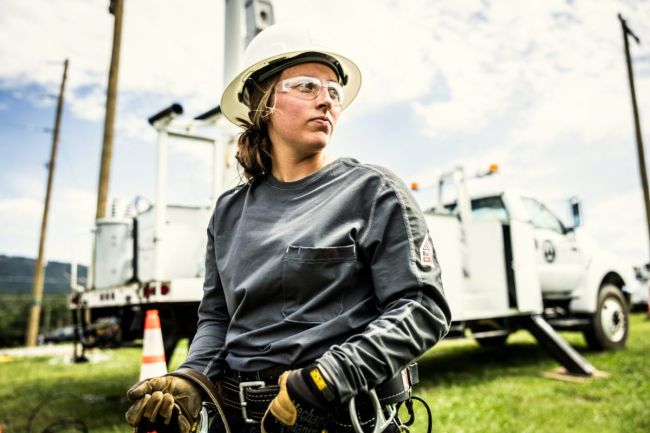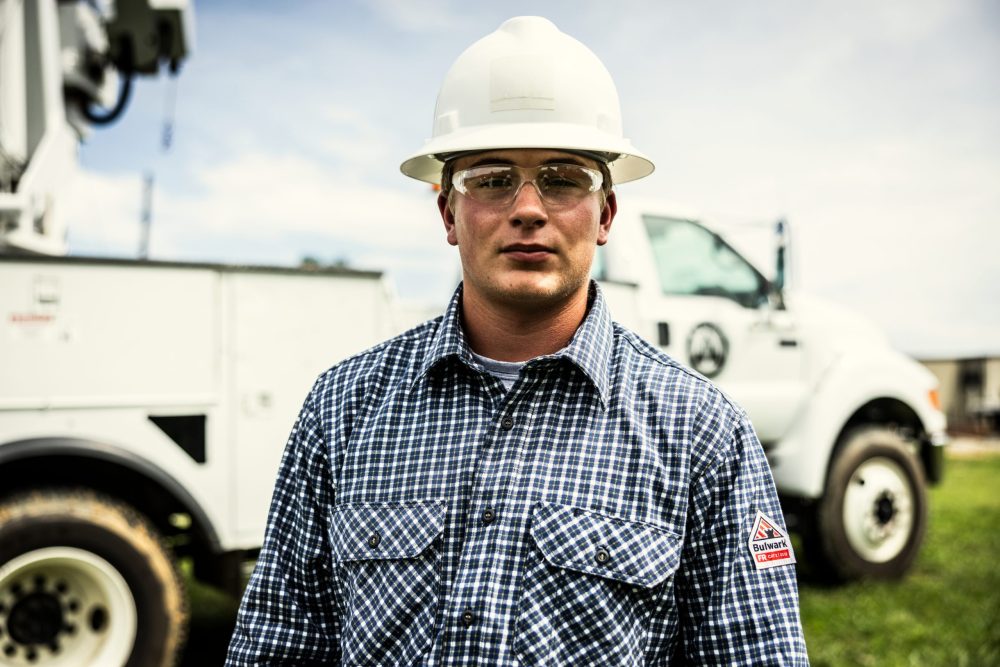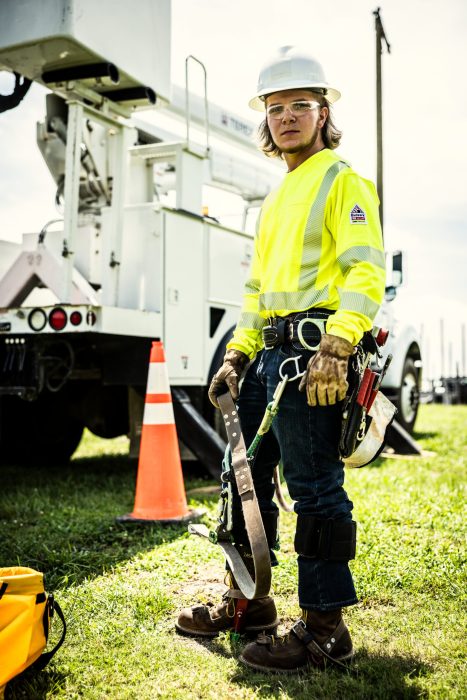
Innovations in FR/AR Clothing: Elevating Comfort for Optimal Performance
Textile advancements available in today’s garments offer improved performance in extreme temperatures.
In the utility industry, the reliance on flame-resistant (FR) and arc-rated (AR) garments has been a longstanding practice to safeguard workers against arc flashes and flash fires. Crafted from specially engineered, self-extinguishing fabrics and adhering to stringent testing standards, these garments play a crucial role in preventing or minimizing the severity of injuries.
You should know that single-layer FR/AR clothing does not trap heat or restrict heat removal any more than regular non-FR clothing does. A person primarily sheds heat through evaporation of sweat once the air temperature is greater than their body’s temperature. When the ability to sweat is restricted, however, or when it is lost altogether – due to physiological conditions, such as dehydration, and/or clothing that restricts it, such as rain gear – the possibility of heat stress increases.
Fortunately, advancements in textiles available in today’s FR/AR garments offer improved performance in extreme temperatures. For instance, moisture management is one advancement that assists in keeping the user comfortable. In hot temperatures, lightweight FR/AR garments allow more heat to be released because they provide less insulation. The open weave allows more air to pass through the garment and assists in moisture evaporation, which, when combined with the garment’s moisture-wicking properties, moves more moisture to the surface of the clothing for evaporative cooling.
In the ever-evolving landscape of FR/AR clothing, the quest for comfort has taken center stage. The latest innovations in this type of clothing are not just about protection; they delve into purposeful design and optimal fit to enhance wearer comfort. This article explores the industry’s advancements in creating FR/AR garments that prioritize both protection and comfort.
Heat Stress
Heat stress occurs when the body cannot rid itself of excess heat. According to the National Institute for Occupational Safety and Health, heat stress is a series of conditions called heat-related illnesses; these illnesses include heat rashes, heat cramps, heat exhaustion and heat stroke. Per NIOSH, “heat can also increase the risk of injuries in workers as it may result in sweaty palms, fogged-up safety glasses, and dizziness” (see www.cdc.gov/niosh/topics/heatstress/).
To help prevent the onset of heat stress, following are basic recommendations for employees tasked with performing work in hot temperatures:
- Boots should be lightweight yet protective.
- Head protection should incorporate shade when possible.
- Hand protection should incorporate lightweight, breathable material when possible.
- Schedule jobs for cooler parts of the day.
- Limit the amount of time spent outside on extremely hot days and move to cool locations during breaks.
- For long, demanding jobs, use relief workers or assign extra workers.
- Make sure there is ready access to cold beverages; try to avoid those with caffeine and sugar.
- Eat regularly to keep up your energy but avoid heavy foods that are hard to digest.
- Avoid touching hot metal surfaces with your bare skin.
- Monitor your physical condition and that of your co-workers. Speak up if you see anyone having difficulties, such as sweating heavily, looking pale, experiencing nausea or vomiting, or feeling dizzy.
Incorporating FR/AR garments into a comprehensive personal protective equipment program aligns with OSHA’s mandate to provide a safe working environment free from recognized hazards that may lead to death or serious physical harm. However, as temperatures fluctuate, questions arise about maximizing protection while minimizing the risk of heat stress.

It is imperative to understand how our bodies respond to hot weather conditions. The continuous effort to maintain a core temperature of around 98.6 degrees Fahrenheit becomes challenging when external temperatures rise. Our bodies rely on four mechanisms – radiation, conduction, convection and evaporation – to release excess heat. When these mechanisms are compromised, the risk of heat-related illnesses intensifies.
Clothing, regardless of type, hinders the efficient operation of the body’s heat-releasing mechanisms. Once outside temperatures surpass the body’s internal temperature, these mechanisms reduce to a single process: evaporation. This can lead to excessive sweating and subsequent dehydration, impacting reaction time and posing safety hazards. Interestingly, sweat also plays a role in cold weather safety, where accumulated moisture under clothing can lead to a drop in body temperature, causing cold stress-related conditions.
To protect workers from injury due to an arc flash or flash fire, and to counter heat stress, it is paramount to select FR/AR garments appropriately rated for the hazard. Standards such as ASTM F1506, ASTM F1891, NFPA 2112 and ASTM F2733 offer guidance. Consideration should also be given to fabric characteristics, such as the following:
- Open-weave fabrics, which enhance air contact with the skin, promoting convection.
- Lighter-weight fabrics with an open weave, which facilitate the release of excess heat through radiation.
- Moisture-wicking garments, which aid in evaporation by moving moisture away from the skin.
Monitoring workers wearing additional PPE layers, such as arc flash suits or rain gear, is crucial to prevent heat retention or hindered evaporation.
The Impact of Purposeful Design

Let’s be honest, “comfort” isn’t exactly the first word that comes to mind when most people in the safety industry think of FR/AR garments. However, purposefully designed clothing, crafted with movement in mind, has emerged as a meaningful change in hot environments. The emphasis is on loose clothing, allowing for better circulation and airflow to mitigate the challenges posed by elevated temperatures. The focus is not just on protection but on garments that facilitate freedom of movement, recognizing the importance of comfort in demanding work conditions.
Optimizing Airflow with Minimal Layers
The latest innovations prioritize minimizing garment layers to maximize high airflow engineered into the fabrics. This departure from excessive fabric mass allows for more effective heat release. Striking a balance between protection and breathability, these advancements allow wearers to experience the benefits of natural air circulation, essential for comfort in challenging work environments.
The Crucial Role of Fit
How you wear FR/AR clothing and the fit of that clothing are critical elements in assuring optimal comfort. The relentless pursuit of the best fit is a universal goal across the industry. Fit considerations go beyond brand-specific claims, acknowledging the importance of a well-fitted garment in promoting wearer comfort and overall satisfaction.
Standardized Sizing and Expert Involvement
The ASTM D13.55 Committee on Body Measurement for Apparel Sizing plays a pivotal role in establishing global standards for human body measurements. The commitment to optimal fit is evident as clothing brands draw on ASTM D13.55 data, often incorporating it into their intellectual property for pattern creation and size run development.
Integration of FR/AR Fabric with Design and Fit
The synergy between the right FR/AR fabric, purposeful design and an optimal fit creates a protective barrier against radiant heat while facilitating air circulation through the fabric.
Additional Tips
Regardless of temperature, work efficiency is enhanced by incorporating loose clothing for improved airflow as well as purposefully designed garments that facilitate movement. Full-body protection against direct and indirect exposure to extreme conditions is crucial. Conducting wear trials before purchase or rental ensures the chosen garments are both comfortable and functional.
Moisture-wicking FR/AR base layers offer additional thermal protection and efficient moisture management. Adhering to industry standards, particularly verifying the outermost FR/AR layer’s sufficient arc rating, is vital to prevent break-open and maintain system integrity.
Lastly, drawing from the insights of occupational physician Ronda McCarthy, it proves beneficial to incorporate NIOSH-recommended measures and utilize the OSHA-NIOSH Heat Safety Tool app (see www.cdc.gov/niosh/topics/heatstress/heatapp.html). Best practices – such as hydration, rest breaks, acclimatization programs and awareness of symptoms – contribute to overall worker safety.
Conclusion
Combining PPE with weather-related engineering controls, education and training forms a robust and effective safety solution. The synergy of these elements helps to assure comprehensive protection against heat stress, arc flashes and flash fires.
About the Authors: Derek Sang, CSHEP, QSSP, is the senior technical training manager for Bulwark Protection. He has served the FR/AR clothing industry for more than 25 years. Reach him at derek.sang@bulwark.com.
Allison Bloodworth is Bulwark Protection’s director of merchandise. She has spent the last 25 years merchandising and developing apparel. Reach her at allison.bloodworth@wwof.com.

